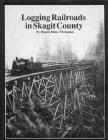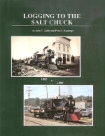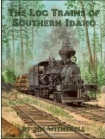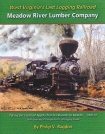This book details the logging history of several lumber & timber companies located in Skagit County of Washington. There are many many photos of Shay locomotives, some of Heisler and Climax locomotives in use. In addition to the locomotive photos, there are many photos of loggers, logging operations, sawmills, along with interesting stationary steam "donkey" and huge timber "yarding" engines used to pull, haul, drag, and hoist the huge virgin timber logs to a site where they could be loaded on rail log cars for transport to the saw mills. The book is well written and illustrated with well over 100 quality B&W photographs. Before and after reading the book, it is hard for one to imagine so much timber and logging activity could have taken place in a single county anywhere in the United States. Superb Recommended - Buy It! ~ Logging Railroads in Skagit County
"For a period of more than 50 years during the late 19th and early 20th centuries, the Saco River Valley and its tributaries were the scene of some of the most intensive logging ever to take place in the rugged and wild White Mountains of New Hampshire. In Logging Railroads of the Saco River Valley, retired Vermont forester and long time railroad buff Bill Gove takes readers back to the days when timber was king in the Whites and lumberjacks jut their way through the virgin wilderness tracts of New England's most famous mountain region.
Based on more than 30 years of research, Gove's book examines the colorful history of the six logging railroad lines that once operated along or near the scenic Saco River, and the many controversial figures who were behind these labor-intensive timber operations. Among the half dozen rail lines covered in the book are the Sawyer River, Swift River, Bartlett & Albany, Saco Valley, Rocky Branch, and East Branch Railroads.
Logging Railroads of the Saco River Valley features more than 150 vintage photographs from this unique era in northern New England history, Plus nearly a dozen original maps, and several charts detailing practically every aspect of the various logging operations."
Logging Railroads of Weyerhaeuser's Vail and McDonald Operation
"Mallets and Much More! Logging Railroads of Weyerhaeuser's Vail-McDonald Operation covers the fascinating history of northwest railroad logging--including the Chehalis Western and the Curtis, Milburn & Eastern--as only Weyerhaeuser could do it. Starting with steam power and evolving to diesel power, Weyerhaeuser harvested and transported logs for some 65 years via their Vail-McDonald operation. Authors Frank Telewski and Scott Barrett capture the story through detailed research and in depth interviews with many Weyerhaeuser employees who share their experiences of life and work in the woods. Thanks to noted northwest logging photographers Clark and Darius Kinsey you'll find a host of imagery inside, including Shay, Climax, Heisler, and rod locomotives--featuring the second largest logging mallet ever built. Also depicted are the powerful steam donkeys and imposing tower skidders Weyerhaeuser used to harvest the massive timbers that grew in Southwestern Washington State."
Over 100 years of railroad logging in Mason County, Washington.
As noted by the distributor, Oso Publishing Company :
"Simpson Timber Company has the distinction of being both the oldest logging railroad in the state of Washington and the only logging railroad in the United States to still operate today! This is the story of Simpson Timber plus all the other logging lines that operated in Mason County, Washington, from the earliest days. The book is profusely illustrated with both photographs and maps, and you'll see an incredible variety of equipment and settings. There are a few color shots of Simpson's distinctive red locomotives running in modern times, plus there's a great appendix of drawings, including a Gibson speeder, a Clyde track layer, Camp Grisdale, and more, including some locomotives. 192 pages, hard bound with a dust jacket, and hundreds of great photos. Definitely a classic book on early railroad logging!"
Log Trains of Southern Idaho
A history of the Southern Idaho railroads and logging operations of the Boise Payette Lumber and Hallack & Howard Lumber companies.
Mallets on the Mendocino Coast - Casper Lumber Company Railroads and Steamships
"Operating from 1861 until 1955, the Caspar Lumber Company's mill at Caspar, CA, was supplied with timber for 75 of those years by the company's own private railroad. They operated a fascinating array of motive power over the lightest of rail, crossing streams on tall timber trestles, to bring in virgin redwood logs from the forest. . . . The Caspar Lumber Company also operated a fleet of coastal schooners, both sail and steam, to carry lumber from the "doghole" landing at Caspar to San Francisco and elsewhere" ~ Timber Times
Matches, Flumes, and Rails
The Diamond Match Co. in the High Sierra
"The complete story of West Virginia's biggest and last logging railroad, from 1912 to its end in 1971, when the last log train arrived in Rainelle, W. Va. just before the mill was closed. The mill was built in 1910 and the first log trains ran in 1912. By 1929 Meadow River Lumber Company was the largest producer of hardwood lumber in the world, exporting its prodigious output via the Nicholas, Fayette & Greenbrier Railroad down to the Chesapeake & Ohio mainline in the New River gorge. In 1958 the first diesels came to supplant the Shays, Heisler, and Climax that had powered the trains up until that time. Meadow River's log trains used the rails of the NF&G for parts of their runs. NF&G was jointly owned by NYC and C&O and tapped the Greenbrier Coal Fields in addition to hauling lumber." ~ TLC Publishing
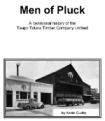
ISBN 0-473-07505-9 ~ 56 pages, 18 photos, 1 map
Price $US 5.00 + $US 3.00 p&p for US/Canada orders
Reviewed by Tom Rogers in the "The Whirl",
a staff magazine published by the Industrial Research Limited of New
Zealand:
"... I soon discovered it was a compelling story of a former
pioneering Central North island timber industry giant, Taupo Totara Timber
Company (TTT) and the great contribution it made towards the early
development of New Zealand.
While in many respects the story mirrors the general pattern of indigenous forest exploitation right around early New Zealand, it has several unique features. It is very much a story of large scale early timber industry pioneering under extreme conditions, succeeding against almost all odds and successfully making the transition to Radiata pine in the 1950s - a remarkable achievement. TTT was one of the first large private companies to accept the enormous challenge of exploiting some of the finest Podocarp forests in the North Island. It all began in the Mokai region devoid of roads, rail and community infrastructure. The author covers very well the early forest purchase, the 1901 company formation, sawmills construction, Mokai township development, railway construction to Putaruru and the ups and downs of timber sales.
The building of the railway line, bridging of the Waikato river, trials and tribulations of its operation and the impact of it on farming is a fascinating story ..."
Web visitors can order the book by writing (with payment) to:
Kevin Cudby
P.O. Box 38209
Wellington Mail Centre
New Zealand
The Mill on the Boot: The Story of the St. Paul and Tacoma Lumber Company
